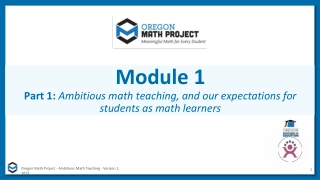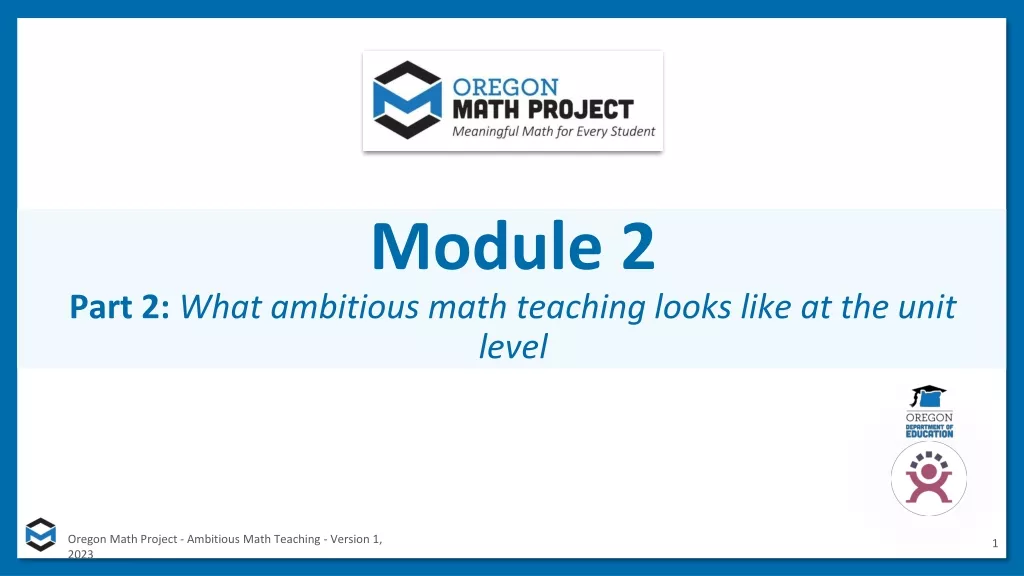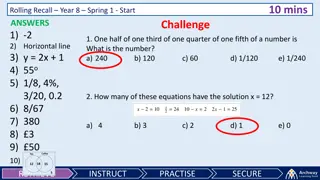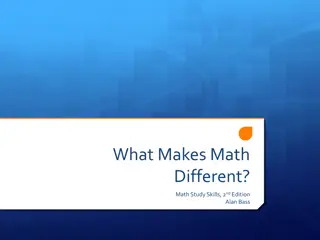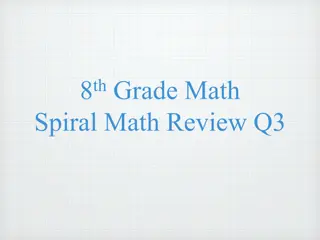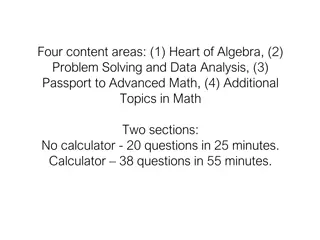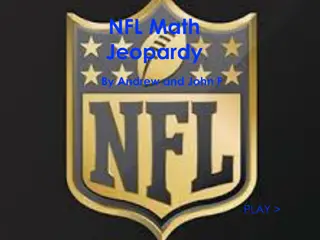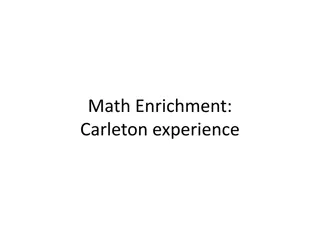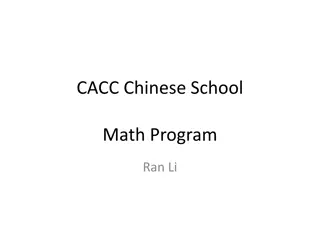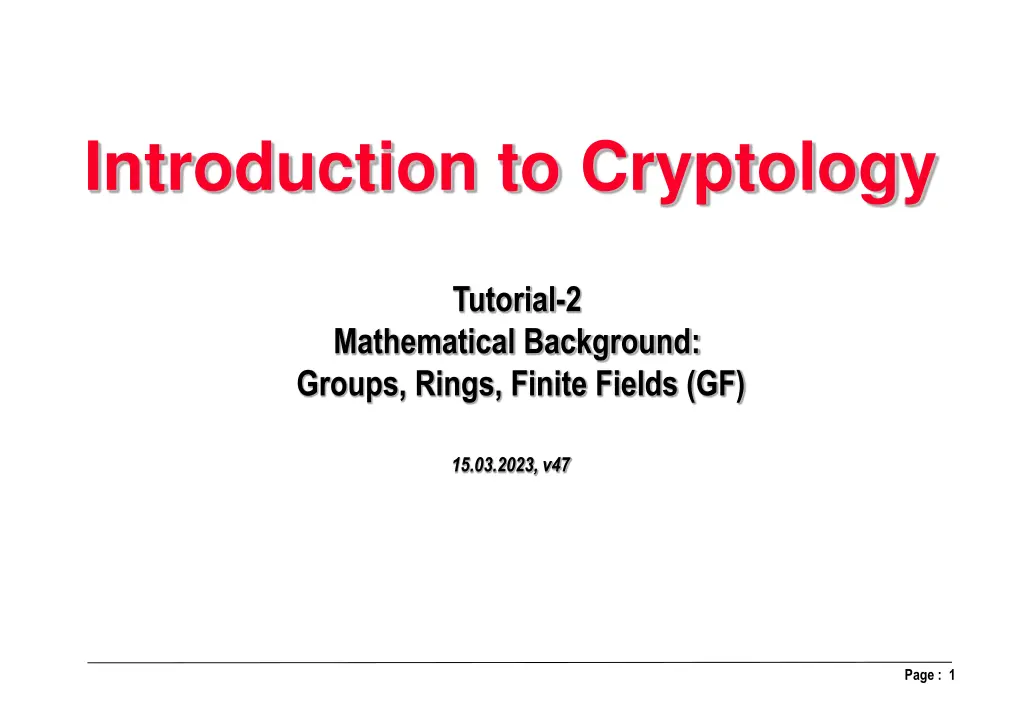
Cryptology Mathematical Background: Groups, Rings, Finite Fields Overview
Explore the mathematical concepts of groups, rings, and finite fields in cryptology. Learn about the Euler function, multiplicative orders, and element orders in the ring of integers modulo m. Solve problems related to invertible elements, multiplicative orders, and element orders in Z33.
Download Presentation

Please find below an Image/Link to download the presentation.
The content on the website is provided AS IS for your information and personal use only. It may not be sold, licensed, or shared on other websites without obtaining consent from the author. If you encounter any issues during the download, it is possible that the publisher has removed the file from their server.
You are allowed to download the files provided on this website for personal or commercial use, subject to the condition that they are used lawfully. All files are the property of their respective owners.
The content on the website is provided AS IS for your information and personal use only. It may not be sold, licensed, or shared on other websites without obtaining consent from the author.
E N D
Presentation Transcript
Introduction to Cryptology Tutorial-2 Mathematical Background: Groups, Rings, Finite Fields (GF) 15.03.2023, v47 Page : 1
Summary: Ring of Integers modulo m Zm Euler Function (m) gives the number of invertible elements in Zm 1 1 (m) = m ( 1 (m) = (p1 1) (p2 1) (p3 1) e1 e2 e3 et ) ( 1 ) For m = p1 p2 p3 .... pt For m = p1 p2 p3 .... pt P1 P2 Order of elements in the Ring of Integers modulo m: Zm The invertible elements in Zmbuild a multiplicative group called Z*mwith the following properties : The number of elements in Z*mis (m) Z*mis a cyclic group if it contains an element with the order (m) The order of any element in Z*mdivides (m) If the order of is k then Ord ( i) = k / gcd (i,k) special case: If the order of is k then the other elements with order k are ( i) where gcd (i,k) = 1 Number of elements with order k is = (k) if Z*mis a cyclic group Page : 2
Summary: Euler and Carmichael Theorems Euler s Theorem For any unit u in Zmwhere gcd (m, u) = 1 ( or for any element in Z*m ) , the following holds: u (m)= 1 (in Zm) Fermat s Theorem (a special case of Euler s theorem): For m=p, where p is prime => up-1 = 1 in Zpfor any integer u Carmicheal s Theorem The greatest order of an elements in Z*mis called Carmichael s function (m): (m) divides (m), for any u Z*m, u (m)= 1 in Z*m Carmicheal s function (m) : (2) = 1, (22) = 2, (2e) = 2e-2 for e 3: (pe) = (pe) = (p - 1)pe-1 for p odd prim. for m = p1e1 p2e2p3e3... pnen (m) = lcm [ (p1e1 ), (p2e2 ), (pnen) ] Page : 3
Problem 2-1: Elements of Z33 1. How many invertible element under multiplication do exist in Z33(number of units in Z33)? 2. Which multiplicative orders are possible in Z*33? 3. Compute the order of the element 2, 5 and 7 in Z33. 4. Compute 3 other elements having the same order as 2, 5, and 7. 5. Compute the order of the elements 10,32,23. 6. Compute the order of elements 4 and other elements having the same order. Solution 2-1: 1. Number of invertible elements (units) is Euler function (33) = (3*11) = (3-1)(11-1) = 20 The 20 units in Z33are: u = {1,2,4,5,7,8,10,13,14,16,17,19,20,23,25,26,28,29,31,32 } = Z*, (gcd (33,u) = 1) 2. Possible multiplicative orders of units in Z33are the divisors of (33) =lcm[ (11), (3)] = lcm(10,2) = 0*2/gcd(10,2) = 10 => Possible orders are the divisors of 10, which are 1, 2, 5, 10 3. Order of 2: 21= 2 1, 22= 4 1, 25= 32 = -1 1 => order of 2 is 10 Order of 5: 51= 5 1, 52= 25 = -8 1, 55= -2*5 = -10 = 23 1 => order of 5 is 10 Order of 7: 71= 7 1, 72= 49 = 16 1, 75= 13*16 = 10 1 => order of 7 is 10 4. If order = k, then ord ( i ) = k iff gcd(k,i) = 1. By selecting i = 1,3,7,9 we get gcd(10,i) = 1. => 21, 23, 27, 29or 2 , 8 , 29 , 17 are 4 elements having order 10 => 51, 53, 57, 59or 5, 26 , 14 , 20 are 4 elements having order 10 => 71, 73, 77, 79or 7 , 13 , 28 , 19 are 4 elements having order 10 5. Order of 10: 101= 10 1, 102= 100 = 1 => order of 10 is 2 Order of 32: 321= 32 = -1 1, 322= 1 => order of 32 is 2 Order of 23: 231= 23 = -10 1, 232= (-10)2 = 100 = 1 => order of 23 is 2 6. Order of 4: 41= 4 1, 42= 16 1, 45= 25*4 = 100 = 1 => order of 4 is 5 For gcd(5,i) = 1 => i = 1,2,3,4 => 41, 42,43, 44 or 4 , 16 , 31 , 25 are elements having order 5 Notice: No. of elements having order 10 is not (10) as Z*33 is not a cyclic group Page : 4
Problem 2-2: Elements of Z17= GF(17) 1. How many invertible element under multiplication do exist in GF(17) (number of units in GF(17) )? 2. Which multiplicative orders are possible in GF(17)? 3. How many elements do exist from each possible order? 4. Compute the order of the element 2 in GF(17). 5. Compute all other elements having the same order as 2. Solution 2-2: 1. Number of invertible elements is Euler function (17) = (17-1) = 16 2. The possible multiplicative orders in GF(17) are the divisors of (17) = 17 1 = 16, namely 1, 2, 4, 8, 16 3. Number of elements with order 1 is (1) = 1 Number of elements with order 2 is (2) = (2-1) = 1 Number of elements with order 4 is (4) = 4 (1-1/2) = 2 Number of elements with order 8 is (8) = (23) = 8 (1-1/2) = 4 Number of elements with order 16 is (16) = (24) = 16 (1-1/2) = 8 4. Order of 2: 21= 2 1, 22= 4 1, 24= 42 = 16 = -1 1 , 28= (24)2 = -12= 1 => order of 2 is 8 5. If order = k, then ord ( i ) = k iff gcd(k,i) = 1. by selecting i = 1,3,5,7 we get gcd(8,i) = 1. => 21, 23, 25, 27or 2 , 8 , 15 , 9 are the 4 elements having order 8 Page : 5
Problem 2-3: Elements of GF(23) 1. How many invertible element under multiplication do exist GF(23) (number of units in GF(23) )? 2. Which multiplicative orders are possible in GF(23)? 3. How many elements do exist from each possible order? 4. Compute the order of the element 2 in GF(23). 5. Compute all other elements having the same order as 2. 6. Compute the inverse of 218 in GF(23) without using the gcd algorithm. Solution 2-3: 1. Number of invertible elements is Euler function (23) = (23-1) = 22 elements 2. The possible multiplicative orders in GF(23) are the divisors of 23 1 = 22, namely 1, 2, 11, 22 3. Number of elements with order 1 is (1) = 1 Number of elements with order 2 is (2) = (2-1) = 1 Number of elements with order 11 is (11) = (11-1) = 10 Number of elements with order 22 is (22) = (2*11) = (2-1)(11-1) = 10 4. Order of 2: 21= 2 1, 22= 4 1, 24= 16 = -7, 25= -14 = 9, 210= 81 = 12, 211= 12*2= 24 = 1 => order of 2 is 11 5. If order = k, then ord ( i ) = k iff gcd(k,i) = 1. By selecting i = 1,2,3,4,5,6,7,8,9,10 we get gcd(11,i) = 1. => 21, 22, 23, 24, 25, 26, 27, 28,29, 210or 2,4,8,16,9,18,13,3,6,12 are the 10 elements having order 11 6. The inverse of 218 is 2-18. The modulus in the exponent is (23) = 23-1 = 22 2-18= 2-18+22= 24= 16. Check 218= (29)2 = 62 = 13 => 16*13 = 208 = 1 in GF(23). Page : 6
Homework: Elements of Z35 1. How many invertible element under multiplication do exist Z35(number of units in Z35)? 2. Which multiplicative orders are possible in Z*35? 3. Compute the order of all invertible elements inZ*35. 4. Find the cycle length for all non-invertible elements. Homework: Elements of Z39 1. How many invertible element under multiplication do exist Z39(number of units in Z39)? 2. Which multiplicative orders are possible in Z*39? 3. Compute the order of all invertible elements in Z*39. 4. Find the cycle length for all non-invertible elements. Homework: Analyze the structure of GF(29), GF(83), Z 216 Z 2n Is a widely used ring in modern cryptography Page : 7

